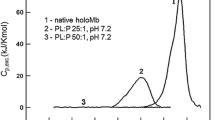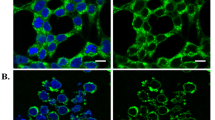Abstract
Biophysical measurements of motion parameters for fluorescent and paramagnetic probes partitioned into membranes of mammalian cells have indicated that the lipid bilayers of the membranes become destabilized as a result of treatment with sublethal doses of pentachlorophenol. Decreases in bulk lipid fluidity of up to 50%, which can be attributed to perturbation of the bilayer by the toxicant, were observed for purified plasma membrane and for preparations of total cell membrane. Spin labels that probe the hydrophobic interior and headgroup regions, respectively, of bilayers indicated that pentachlorophenol does not assume an amphipathic orientation in the membrane, but rather it partitions into the hydrophobic interior of the bilayer. Arrhenius plots of motion parameters were continuously linear over temperatures ranging from 20 to 55°C for both treated and control cells, indicating that pentachlorophenol does not induce lipid phase transitions. Treatment with sublethal doses of pentachlorophenol also induced a decline in levels of phospholipid phosphate per cell that can be attributed to a selective action of phospholipase C. Notwithstanding these changes, the cells remained viable judging from their ability to exclude trypan blue and thus the deleterious effects of pentachlorophenol on membranes can be interpreted as sublethal damage.
Similar content being viewed by others
References
Adamich M, Dennis EA (1979) Action of cobra venom phospholipase A2 toward lipids of erythrocyte membranes. In: Fox C (ed) Normal and abnormal red cell membranes. Allan R Liss Inc, New York, pp 515–521
Allen D, Billah MM, Finean JB, Michell RH (1976) Release of diacylglycerol-enriched vesicles from erythrocytes with increased intracellular Ca2+. Nature 261:58–60
Allen D, Low MG, Finean JB, Michell RH (1975) Changes in lipid metabolism and cell morphology following attack by phospholipase C(Clostidium perfringens) in red cells or lymphocytes. Biochim Biophys Acta 413:309–316
Barber RF, Thompson JE (1983) Neutral lipids rigidify unsaturated acyl chains in senescing membranes. J Exptl Bot 34:268–276
Bevenue A, Beckman H (1967) Pentachlorophenol: A discussion of its properties and its occurrence as a residue in human and animal tissue. Residue Reviews 19:83–134
Bradford MM (1976) A rapid and sensitive method for the quantitation of microgram quantities of protein utilizing the principle of protein-dye binding. Anal Biochem 72:248–254
Buff K, Brundl A, Berndt J (1982) Differential effects of environmental chemicals on liposomal bilayers; fluorescence polarization and pesticide-lipid association studies. Biochim Biophys Acta 688:93–100
Buff K, Berndt J (1981) Interaction of DDT (1,1,1-trichloro-2,2-bis(p-chlorophenyl)-ethane) with liposomal phospholipids. Biochim Biophys Acta 643:205–212
Cinelli DP (1978) Patterns of pentachlorophenol usage in the United States of America—An overview. In: Rao KR (ed) Pentachlorophenol. Plenum Press, New York, pp 13–26
Danner J, Resnick H (1980) Use of the fluorescent probe 1-ani-lino-8-naphthaline sulfonate to monitor the interactions of chlorophenols with phospholipid membranes (liposomes). Biochem Pharmacol 29:2471–2475
Dittmer JC, Wells MA (1969) Quantitative and qualitative analysis of lipids and lipid components. Methods Enzymol 14:482–530
Finean JB, Martonosi A (1965) The action of phospholipase C on muscle microsomes: a correlation of electron microscope and biochemical data. Biochim Biophys Acta 98:547–553
Goormaghtigh E, Van Campenhoud M, Ruysschaert JM (1981) Lipid phase separation mediates binding of pancreatic phospholipase A2 to its substrate. Biochem Biophys Res Commun 101:1410–1418
Gruber MY, Cheng KH, Lepock JR, Thompson JE (1984) Improved yield of plasma membrane from mammalian cells through modifications of the two-phase polymer isolation procedure. Anal Biochem 138:112–118
Grunwald C (1970) Sterol distribution in intracellular organelles isolated from tobacco leaves. Plant Physiol 45:663–666
Hayes A (1978) Transport processes as sites of action of toxic chemicals. Fed Proc 38:2218–2219
Holmberg B, Jensen S, Larsson A, Luvander K, Olsson M (1972) Metabolic effects of technical pentachlorophenol (PCP) on the eelAnguilla anguilla. Comp Biochem Physiol 43:171–183
Keith A, Bullfield G, Snipes W (1970) Spin-labelledNeurospora mitochondria. Biophys J 10:618–629
Lakowicz JR, Hogan D (1976) Diffusional transport of toxic materials in membranes studied by fluorescence spectroscopy. In: Miller MW, Shamoo AE (eds) Membrane Toxicity. Plenum Press, New York pp 509–546
Lepock JR, Morse PD II, Mehlhorn RJ, Hammerstedt RH, Snipes W, Keith AD (1975) Spin labels for cell surfaces. FEBS Lett 60:185–189
Morrison WR, Smith LM (1964) Preparation of fatty acid methyl esters and dimethylacetals from lipids with boron tri-fluoride-methanol. J Lipid Res 5:600–608
Packharn ED, Thompson JE, Mayfield CI, Inniss WE, Kruuv J (1981) Perturbation of lipid membranes by organic pollutants. Arch Environ Contam Toxicol 10:347–356
Packham ED, Duxbury CL, Mayfield CI, Inniss WE, Kruuv J, Thompson JE (1982) Quantitative analysis of pollutant-induced lethal and sublethal damage in cultured mammalian cells. Bull Environ Contam Toxicol 29:739–746
Reich T, Depew MC, Marks GS, Singer MA, Wan JKS (1981) Effect of polychlorinated biphenyls (PCBs) on phospholipid membrane fluidity. J Environ Sci Health A16:65–71
Roberts DR, Dumbroff EB, Thompson JE (1986) Exogenous polyamines alter membrane fluidity in bean leaves—a basis for potential misinterpretation of their true physiological role. Planta 167:395–401
Shinitzky M, Barenholz Y (1978) Fluidity parameters of lipid regions determined by fluorescence polarization. Biochim Biophys Acta 515:367–394
Sklar LA, Hudson BS, Petersen M, Diamond J (1977) Conjugated polyene fatty acids on fluorescent probes: Spectroscopic characterization. Biochem 16:813–819
Villanueva EC, Burse VW, Jennings RW (1973) Chlorodibenzop-dioxin contamination of two commercially available pentachlorophenols. J Agric Food Chem 21:739–740
Weinbach EC, Garbus J (1965) The interaction of uncoupling phenols with mitochondria and mitochondrial protein. J Biol Chem 240:1811–1819
Williams JC, Melhorn R, Keith AD (1971) Synthesis and novel uses of nitroxide motion probes. Chem Phys Lipids 7:207–230
Author information
Authors and Affiliations
Rights and permissions
About this article
Cite this article
Duxbury, C.L., Thompson, J.E. Pentachlorophenol alters the molecular organization of membranes in mammalian cells. Arch. Environ. Contam. Toxicol. 16, 367–373 (1987). https://doi.org/10.1007/BF01054955
Received:
Revised:
Issue Date:
DOI: https://doi.org/10.1007/BF01054955




